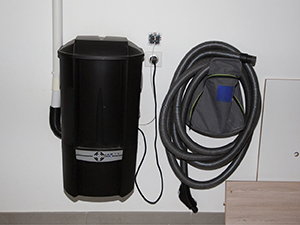
Should You Invest in a Central Vacuum System?
As we know, vacuuming our home’s floor surfaces is the first line of defense against dirt and grime building up. This buildup can make floors look dirty and dingy or it can cause the floors and carpet fibers to be damaged. Vacuuming is essential to floor surface care.
Today’s homes often have mixed floor surfaces such as: hardwood, area rugs, tile, and wall-to-wall carpet. Not all vacuum cleaners are meant to clean all surfaces. You may end up having to buy more than one type of vacuum cleaner to take care of your surfaces. Plus, if you have a multi-level home with stairs, you either have to buy multiple vacuums for each level or you have to lug vacuums up and down the stairs to get all your surfaces clean. What a drag. If this does not appeal to you, think about installing a central vacuum system in your home. Let’s take a look at some the pros and cons of central vacuum systems.
Pros:
- Warranties: Most systems come with multiyear warranties, some up to 10 years. Whereas, most portable vacuums, even the high-end ones come with a one-year warranty.
Suction: Since the motors on central vacuum systems are so much larger, they have much more powerful suction, enabling you to pick up more dirt and debris. - Convenience: Instead of lugging a heavy, portable vacuum around, with a central vacuum system, you only need to carry the hose AND if you get a retractable hose option at your ports, you won’t even need to carry that.
- Options: There are tool options for all your flooring needs and there are options for the systems such as wet/dry to help with spills, HEPA filters, retractable hoses, and baseboard dust slots to eliminate the need for dustpans. You can sweep directly into the slot.
- Noise: Regular, mobile vacuums have a noise rating of 70-85 decibels, approximately the sound level of a lawn mower. It annoys kids and pets alike. A central vac system goes to roughly 60 decibels or about the same as a window air conditioner. Quieter and much less annoying.
- Air Quality: Since the suction is superior to that of a standard vacuum cleaner, it eliminates more allergens and dust. Plus, it sucks these things out of your immediate living area, and you only have to empty the dust container a few times a year reducing your exposure to these irritants.
Cons:
- Expense: The initial outlay for a system, depending on options, location, and brand can be upwards of several thousand dollars.
- Energy: Central vacuum systems have larger motors and more suction power, so they require more energy than smaller, portable vacuum cleaners.
- Storage: If you don’t get retractable hose ports, hoses can be up to thirty feet long, taking up much more space in a closet than a regular vacuum cleaner.
- Suction: While a central vacuum system has more powerful suction than a standard vacuum, that can be a problem. If you are not careful, the extra power can accidentally suck things up you wanted to keep. Or it can suck up items too big for the system causing clogs or other malfunctions.
- Potential Damages: Hoses can reach up to thirty feet enabling multi- room cleaning. However, unless you are careful, hoses can rub on walls and furniture causing wear, scuffs, and other damage.
- Repairs: If something does go wrong, repairs can be costly, especially if the issue is behind the walls of your home. Some brands require that only certified, licensed technicians work on your system, or the warranty may be voided.
Whether you decide to invest in a central vacuum system or not, vacuuming alone should only be considered the first line of defense against carpet wear. While vacuuming does help prevent premature wear and damage, it does not replace the routine, deep cleaning performed by professionals. The three-pronged approach of: taking care of spills and stains immediately, proper vacuuming and routine deep cleaning is the best way to keep your carpets and rugs looking their best for years to come.
By Sharon Koehler. This article is one of a series of articles written and published on behalf of Surface Care PRO Partners.






